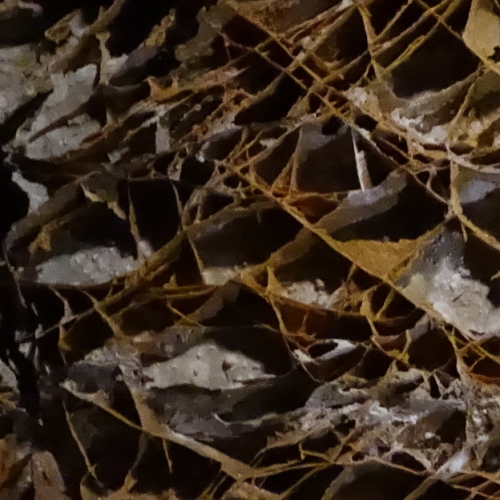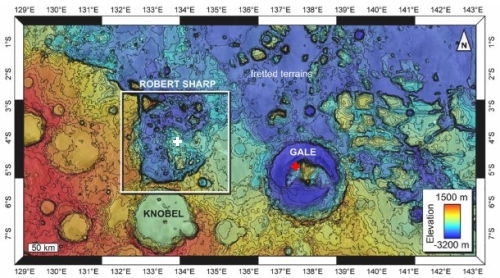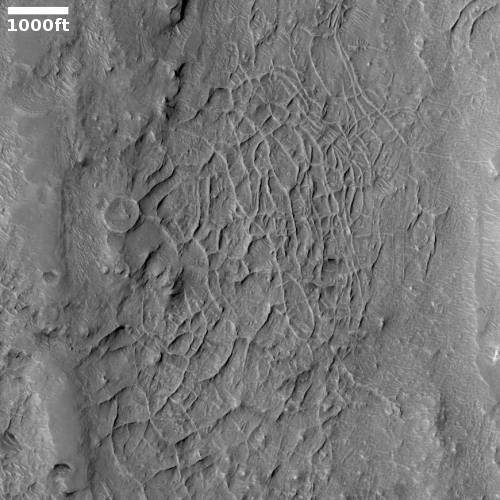Cave boxwork on the Martian surface

Boxwork inside Wind Cave, South Dakota, mere inches across.
Anyone who has ever visited either Wind or Jewel caves in South Dakota has likely seen some wonderful examples of the cave formation boxwork, formed when the material in cracks is more resistant to erosion that the surrounding bedrock, which once eroded away leaves behind the criss-crossing ridges seen in the picture to the right.
Today’s cool image provides us what appears to be an example of boxwork on Mars. However, unlike on Earth it is not in a cave but on the surface. It is also much larger. Instead of the ridges being almost paper thin and stretching for inches or feet, this Martian boxwork is feet wide with ridges extending hundreds of feet in size, as shown by today’s cool image below.
The image to the right, cropped and reduced to post here, was taken by the high resolution camera on Mars Reconnaissance Orbiter (MRO) on February 4, 2021. It shows what the scientists have labeled “polygonal ridges” on the floor of 90-mile wide Robert Sharp Crater, located directly to the west of Gale Crater near the Martian equator in the transition zone between the northern lowland plains and the southern cratered highlands.
Requested by Jeremy Brossier of Wesleyan University, I emailed him to ask him for more information, and he immediately sent me a copy of a 2020 paper that he co-wrote describing the entire known geology of Sharp Crater. From the paper’s section describing these polygonal ridges:
Such ridges are interpreted as fractures filled and cemented by minerals that were precipitated from near-surface groundwater. … Polygonal ridges in Robert Sharp show similarities with polygonal ridges in Gale [crater] in terms of morphology, but not in size. Gale’s polygonal ridges are smaller than those in Robert Sharp and are tens of meters long. In Gale, they have been attributed to the preferential cementation of material due to the circulation of fluids through fracture systems.
In other words, their formation is similar in basic principles to the boxwork found in caves on Earth. The material cemented into the cracks remains when the softer surrounding bedrock erodes away.

The overview map to the right, figure 2 in Brossier’s paper, shows the location of this photo by the white cross, with the red cross indicating where Curiosity is presently roving in Gale Crater. The fretted terrain is also called chaos terrain, and is found abundantly in the transition zone bordering the northern lowlands. At higher latitudes it is home to many glaciers. Here, at the equator, there is little or no evidence of glaciers, though they might have existed in the past.
What the scientists believe is that both Sharp and Gale were shaped by a variety of geological processes involving water, including flowing water or ice as well as lakes. The history of the two craters were somewhat different, since the northern rim of Robert Sharp Crater has been breached and the crater is far more eroded. That very complicated history is thought to have begun billions of years ago. After impact the crater was eroded, than its interior filled, than eroded, and then filled again (likely with wind-blown volcanic ash). About an estimated 3 billion years ago there was also a lake here, which when it disappeared left behind deltas and channels.
The surface boxwork is thought to have formed in conjunction with the water that formed the lake, though the details remain very vague and will require a lot more information in order to determine those details with any confidence.
It was a desire to obtain that additional information that prompted Brossier to request this image. As he explained in his email, “I studied the Robert Sharp crater to highlight the past aqueous phases that existed therein. While doing this, I found a lot of these polygonal ridges (or boxworks). So, I decided to request high resolution images.”
On Christmas Eve 1968 three Americans became the first humans to visit another world. What they did to celebrate was unexpected and profound, and will be remembered throughout all human history. Genesis: the Story of Apollo 8, Robert Zimmerman's classic history of humanity's first journey to another world, tells that story, and it is now available as both an ebook and an audiobook, both with a foreword by Valerie Anders and a new introduction by Robert Zimmerman.
The print edition can be purchased at Amazon or from any other book seller. If you want an autographed copy the price is $60 for the hardback and $45 for the paperback, plus $8 shipping for each. Go here for purchasing details. The ebook is available everywhere for $5.99 (before discount) at amazon, or direct from my ebook publisher, ebookit. If you buy it from ebookit you don't support the big tech companies and the author gets a bigger cut much sooner.
The audiobook is also available at all these vendors, and is also free with a 30-day trial membership to Audible.
"Not simply about one mission, [Genesis] is also the history of America's quest for the moon... Zimmerman has done a masterful job of tying disparate events together into a solid account of one of America's greatest human triumphs."--San Antonio Express-News

Boxwork inside Wind Cave, South Dakota, mere inches across.
Anyone who has ever visited either Wind or Jewel caves in South Dakota has likely seen some wonderful examples of the cave formation boxwork, formed when the material in cracks is more resistant to erosion that the surrounding bedrock, which once eroded away leaves behind the criss-crossing ridges seen in the picture to the right.
Today’s cool image provides us what appears to be an example of boxwork on Mars. However, unlike on Earth it is not in a cave but on the surface. It is also much larger. Instead of the ridges being almost paper thin and stretching for inches or feet, this Martian boxwork is feet wide with ridges extending hundreds of feet in size, as shown by today’s cool image below.
The image to the right, cropped and reduced to post here, was taken by the high resolution camera on Mars Reconnaissance Orbiter (MRO) on February 4, 2021. It shows what the scientists have labeled “polygonal ridges” on the floor of 90-mile wide Robert Sharp Crater, located directly to the west of Gale Crater near the Martian equator in the transition zone between the northern lowland plains and the southern cratered highlands.
Requested by Jeremy Brossier of Wesleyan University, I emailed him to ask him for more information, and he immediately sent me a copy of a 2020 paper that he co-wrote describing the entire known geology of Sharp Crater. From the paper’s section describing these polygonal ridges:
Such ridges are interpreted as fractures filled and cemented by minerals that were precipitated from near-surface groundwater. … Polygonal ridges in Robert Sharp show similarities with polygonal ridges in Gale [crater] in terms of morphology, but not in size. Gale’s polygonal ridges are smaller than those in Robert Sharp and are tens of meters long. In Gale, they have been attributed to the preferential cementation of material due to the circulation of fluids through fracture systems.
In other words, their formation is similar in basic principles to the boxwork found in caves on Earth. The material cemented into the cracks remains when the softer surrounding bedrock erodes away.

The overview map to the right, figure 2 in Brossier’s paper, shows the location of this photo by the white cross, with the red cross indicating where Curiosity is presently roving in Gale Crater. The fretted terrain is also called chaos terrain, and is found abundantly in the transition zone bordering the northern lowlands. At higher latitudes it is home to many glaciers. Here, at the equator, there is little or no evidence of glaciers, though they might have existed in the past.
What the scientists believe is that both Sharp and Gale were shaped by a variety of geological processes involving water, including flowing water or ice as well as lakes. The history of the two craters were somewhat different, since the northern rim of Robert Sharp Crater has been breached and the crater is far more eroded. That very complicated history is thought to have begun billions of years ago. After impact the crater was eroded, than its interior filled, than eroded, and then filled again (likely with wind-blown volcanic ash). About an estimated 3 billion years ago there was also a lake here, which when it disappeared left behind deltas and channels.
The surface boxwork is thought to have formed in conjunction with the water that formed the lake, though the details remain very vague and will require a lot more information in order to determine those details with any confidence.
It was a desire to obtain that additional information that prompted Brossier to request this image. As he explained in his email, “I studied the Robert Sharp crater to highlight the past aqueous phases that existed therein. While doing this, I found a lot of these polygonal ridges (or boxworks). So, I decided to request high resolution images.”
On Christmas Eve 1968 three Americans became the first humans to visit another world. What they did to celebrate was unexpected and profound, and will be remembered throughout all human history. Genesis: the Story of Apollo 8, Robert Zimmerman's classic history of humanity's first journey to another world, tells that story, and it is now available as both an ebook and an audiobook, both with a foreword by Valerie Anders and a new introduction by Robert Zimmerman.
The print edition can be purchased at Amazon or from any other book seller. If you want an autographed copy the price is $60 for the hardback and $45 for the paperback, plus $8 shipping for each. Go here for purchasing details. The ebook is available everywhere for $5.99 (before discount) at amazon, or direct from my ebook publisher, ebookit. If you buy it from ebookit you don't support the big tech companies and the author gets a bigger cut much sooner.
The audiobook is also available at all these vendors, and is also free with a 30-day trial membership to Audible.
"Not simply about one mission, [Genesis] is also the history of America's quest for the moon... Zimmerman has done a masterful job of tying disparate events together into a solid account of one of America's greatest human triumphs."--San Antonio Express-News



And if you look really close-you can see the Alien queen laying her eggs in that nest!